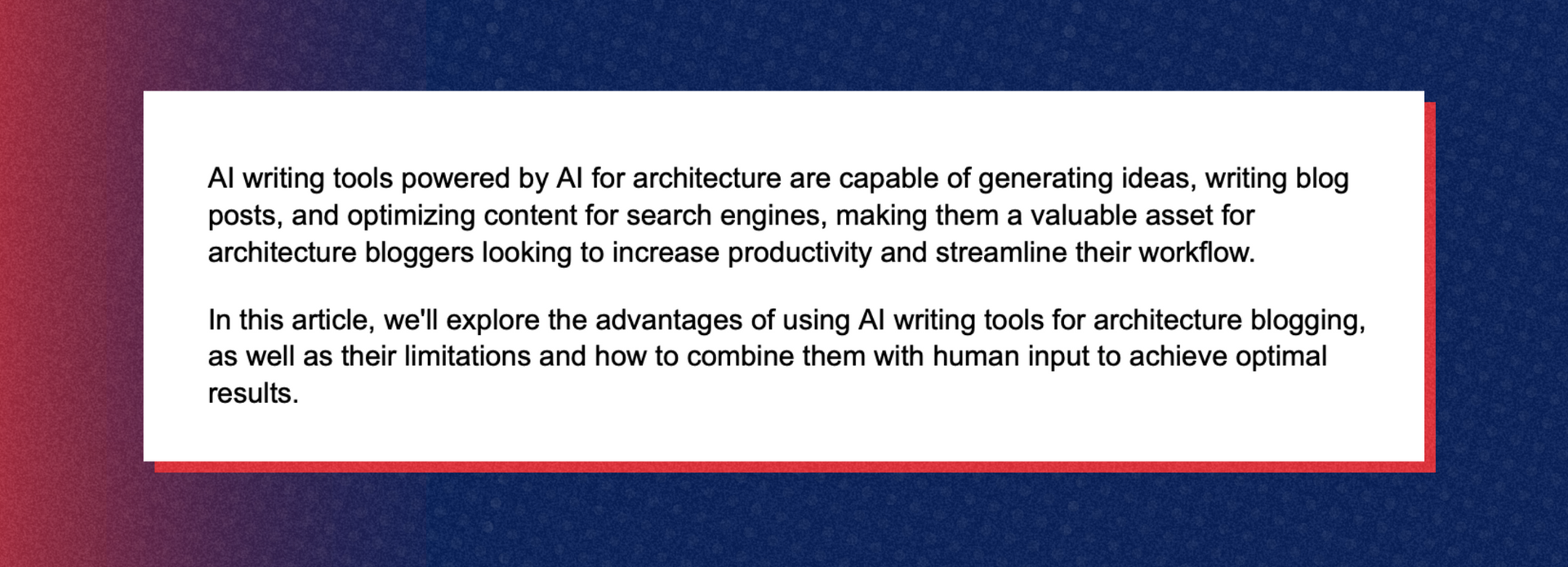Revolutionizing Architecture Blogging with AI: How to Use the Power of AI for Your Blog
As technology continues to advance, we see AI being used more and more in architectural design.
Perhaps you're already utilizing AI for architecture-related tasks, such as:
- Optimizing your design process
- Project management
- Repetitive tasks like payroll and billing
But, did you know you can use artificial intelligence tools to create top-tier blog posts for your architecture blog?
Such AI tools, known as ‘Generative AI,’ use algorithms to create content, including written text, audio, code, images, simulations, and videos.
We often speak with architects who want to blog and create more content, because they now it's the best way to communicate their expertise.
However, many don't because they are already busy with client work and running their firms.
Generative AI can help you create content much more quickly and efficiently.
However, there is a catch: AI doesn't work perfectly every time (YET!) and the results you get from an AI writing tool will still need editing.
This blog post will teach you how to edit AI content to get top quality blog articles for your architecture firm's website. These same principles can be applied to writing articles for Linkedin, and other platforms as well.
Keep reading to explore:
- The advantages of using AI writing tools for architecture blogging
- The limitations of any AI writing tool
- How to combine AI output with human input to achieve optimal results
- The editing process we use at Archmark too get our clients’ blog posts from robotic to human
3 Advantages of Using Artificial Intelligence for Architecture Blogging
We think that in the near future, most of us will be using AI extensively in our work. And there is a good reason for that: It is incredibly helpful.
Here are the top three advantages to using AI for architecture blogging.
1. Increased Productivity and Efficiency

AI writing tools can produce a vast amount of content quickly, allowing architects to concentrate on other responsibilities.
AI can also suggest article ideas based on current trends or topics that are generating high search volume, making it easier to generate fresh content.
What this all means is blogging suddenly has become way less time-consuming.
In fact, according to Fortune.com, a recent study found that Generative AI makes workers 14% more productive, though there is anecdotal evidence to show that gains can be much higher.
With AI, you can efficiently write blog posts that are high quality, without abandoning your other work tasks.
2. Generate Ideas and Suggestions for Content
Sometimes the hardest part of blogging is coming up with good topics.
AI writing tools can generate topic ideas, headlines, and even complete outlines for blog posts.
This takes some of the pressure off when you are struggling with writer's block or can't come up with fresh ideas.
While AI might not always come up with the best solution, it can help get your creativity flowing.
3. Automatic Optimization for Search Engine Rankings
AI writing tools can optimize blog posts for search engines by suggesting keywords, headings, and other on-page SEO elements.
This can help bloggers improve their search engine rankings and attract more readers.
You simply input parameters, like the main keyword, and AI does the rest.
3 Limitations of AI Writing Tools for Architecture Blogging
In the future, AI systems could become so sophisticated that they replace human writers.
For now, they have several limitations. Here are the top 3.
1. Lack of Creativity and Originality
AI writing tools are limited by the algorithms and data they have been trained on, which means they can sometimes produce repetitive or generic content.
Check out the intro that AI wrote for this article:

They are also unable to think outside the box or come up with truly original ideas.
So, if you are looking to write about a topic that hasn't been written about before, you might notice AI struggling.
2. Inability to Understand Cultural Nuances or Idiomatic Expressions
AI writing tools are not able to fully understand cultural nuances or idiomatic expressions, which means they may produce content that is insensitive. Or they might produce something that just won't make sense to your reader.
They might also struggle to understand and convey some newer architectural concepts. Artificial intelligence writing tools pull from information already out there and some are only able to pull from information before a specific date.
So, they are not able to bring in cutting-edge research or brand-new concepts.
3. Difficulty in Generating Personalized or Emotional Content
AI writing tools are not capable of producing content that is emotional or personalized.
This type of content requires a human touch that only humans can provide.
For example, if you're discussing specific architectural styles, artificial intelligence cannot convey the emotions those styles evoke.
Tips for Combining AI Writing Tools with Human Input for Optimal Results
While AI writing tools can be useful for architecture blogging, they are not a substitute for human input. Human input is necessary to ensure the quality and relevance of content.
Here are some ways to combine AI writing tools with human input to achieve optimal results:
Use Machine Learning to Generate Ideas or Drafts
AI writing tools can be used to generate ideas or drafts for blog posts. Don't expect a final draft from AI that you can publish unedited.
AI tools are fantastic when you want to create structures or outlines for your blog posts. That is the main way we use AI writing tools.
Also, if you want to list out all the benefits of some architectural design concepts or the steps for the design, AI will help you quickly create a great list to work with.
While AI writing tools can be useful for architecture blogging, they are not a substitute for human input. Human input is necessary to ensure the quality and relevance of content.
Here are some ways to combine AI writing tools with human input to achieve optimal results:
Leave Final Edits to Humans
While AI writing tools can generate content quickly, they may miss important details or produce awkward phrasing.
Humans should always review and edit the content before publishing, ensuring that it is accurate, engaging, and grammatically correct.
We recommend having a set editing process, just as you probably have a set design process. This will help ensure you cover all your bases.
Keep reading for the editing process we follow for our AI-generated articles.
How We Edit Our AI Blogs
We used AI to write this blog.
Now, did AI spit out exactly what you are reading here? No.
In fact, it still took a good amount of human effort to make sure the writing wasn't robotic and boring.
Here are the 5 steps we take to edit our blogs.
1. Create and Review an AI outline first
We recommend having AI write an outline first. That way you can see the basic structure of the blog post before having to sort through the text.
Then you can edit the outline and ask your AI writing tool to write the blog post based on your edited outline.
2. Remove anything extra
Sometimes AI will write repetitive information, “fluff” (superfluous content), or it can write information that isn’t quite aligned with the message you want to share.
Our first step is to go through the fluff, repetitive, and/or off-topic content and remove or improve it. Our rule of thumb is to remove anything that doesn't add to the blog post.
3. Fact Check
While AI is improving every day, you have to be careful to fact-check its work.
Especially when it comes to complex architectural concepts, you need to make sure that the facts you are listing are true.
If the AI states, for example, that building materials are increasing in cost by 6%, make sure that is true, and where possible, find a source to verify accuracy.
4. Add personality, the right tone, and examples
You know your firm, clients, and design process best, and AI cannot add your unique personality and tone of voice to your blog post.
For example, our team added this entire section to the blog as AI cannot replicate our editing process.
5. Final review and optimization
When writing articles for our clients and ourselves, we always optimize them for SEO to ensure that they will generate traffic. This is a vital step, there is no sense in spending time and energy to write a blog, if no one is going to read it.
The final step is to review the article to make sure it all flows and reads smoothly. Sometimes when you are merging human and AI text, it can sound a little disjointed. Our mission is to make sure it all sounds like one voice.
The Key to Good AI Writing is Human Input
AI writing tools like ChatGPT, Jarvis.ai and many others are quickly becoming powerful tools for architecture bloggers, firm owners, and architecture marketers, but like any new tool, they should be used with a bit of caution.
These and other AI tools are still very new. Unlike many tools of the past, they are evolving rapidly, and as more people use them, the faster they will evolve.
When it comes to architecture firm blogging, they can greatly increase your productivity and efficiency. They allow you to rapidly generate ideas and suggestions for content, and allow you to expertly optimize blog posts for search engine rankings.
However, like any other tool, they have limitations and lack the creativity and emotional intelligence of humans.
The Key to Good AI Writing is Human Input

AI writing tools like ChatGPT, Jarvis.ai and many others are quickly becoming powerful tools for architecture bloggers, firm owners, and architecture marketers, but like any new tool, they should be used with a bit of caution.
These and other AI tools are still very new. Unlike many tools of the past, they are evolving rapidly, and as more people use them, the faster they will evolve.
When it comes to architecture firm blogging, they can greatly increase your productivity and efficiency. They allow you to rapidly generate ideas and suggestions for content, and allow you to expertly optimize blog posts for search engine rankings.
However, like any other tool, they have limitations and lack the creativity and emotional intelligence of humans.
By combining AI writing tools with human input, architects can produce high-quality content that engages and informs their readers, while taking advantage of the strengths of both.
With this approach, bloggers can revolutionize the architecture industry and provide valuable insights and inspiration to their readers.
Apply for a free 20-minute clarity call today to learn more about how we can use AI to write attention-grabbing blog posts for your firm.

Feeling Invisible? Need Help with Branding or Marketing?
If you’re struggling to get quality projects, it may be time to hire an expert. Apply for your free Clarity Call today to learn how Archmark can help your firm thrive!
COMMENTS, QUESTIONS, SUGGESTIONS?
What Do You Think?
Congratulations, you made it to the bottom of the article. Please tell us what you think? Was this information helpful? Do you think we're full of it? This is your chance. We welcome your comments!
Share your thoughts below!
Learn How to improve your recognition, Reputation & reach
Read More Architect Marketing Articles from Archmark!
If there is one thing we love to talk about at Archmark, it's branding and marketing for architects. We have compiled an impressive library of articles over the years to help architects like you better understand how to improve your firm’s recognition, reputation, and reach in the markets you serve. Explore our library below, and when you are ready, apply for your free Clarity Call.

Archmark, a leading marketing agency for architects, has helped more than 3,000 architects use branding and marketing to attract, find and connect with better clients & projects.
Get In Touch
Quick Links
Archmark/Be Brilliant LLC | All Rights Reserved









